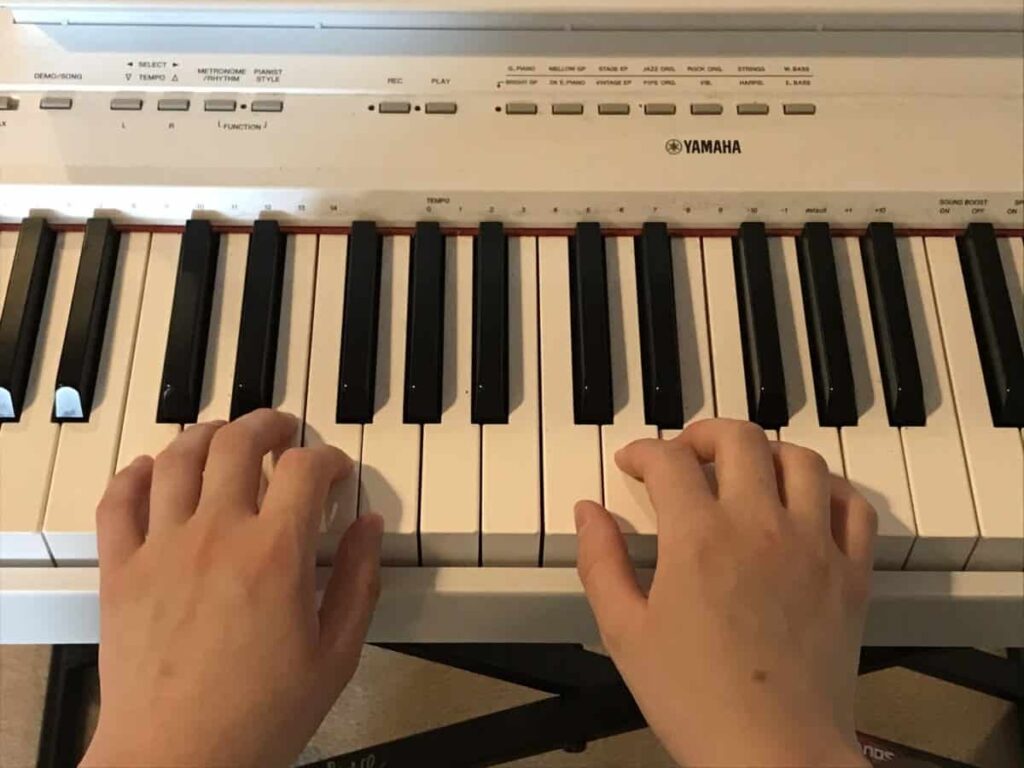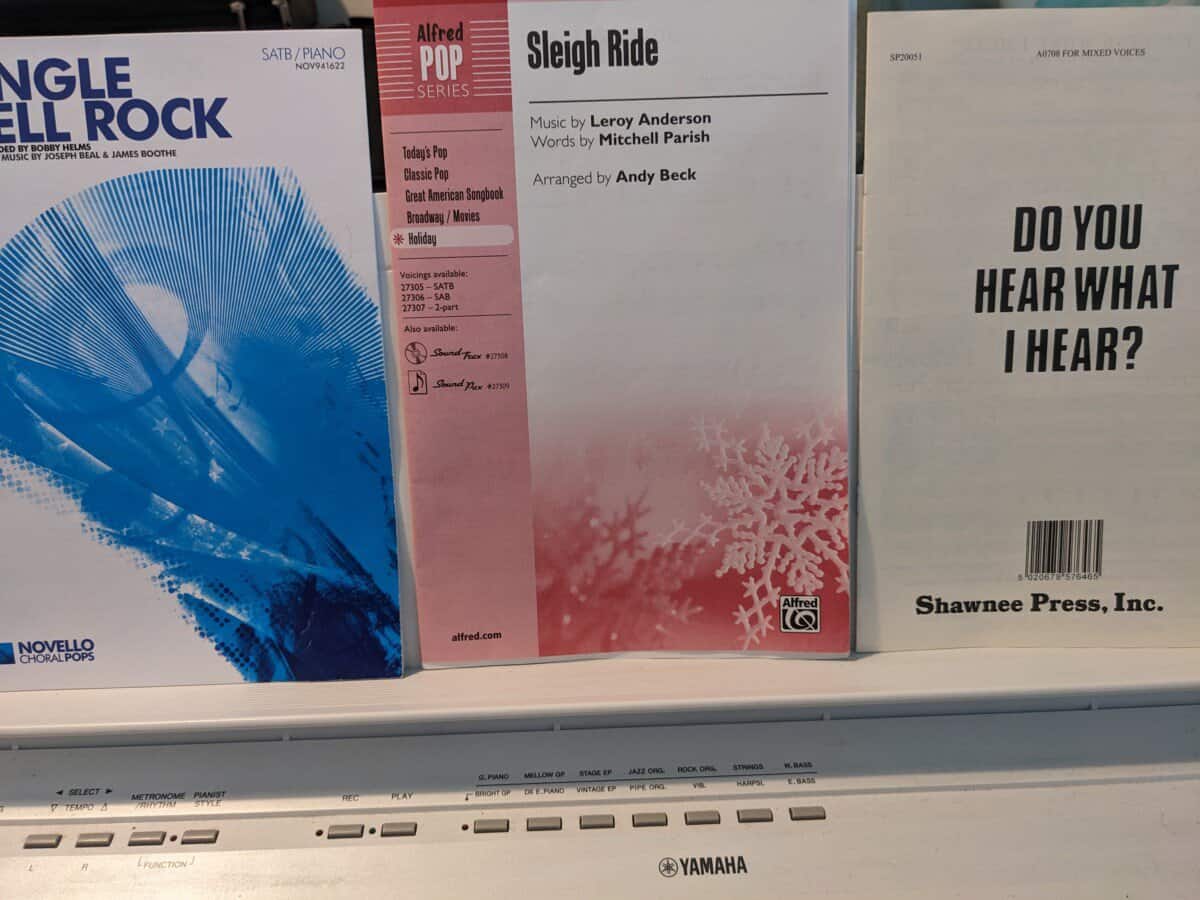Accompanying choirs on the piano can be one of the most fun and fulfilling ways to spend your time. I’ve been accompanying choirs since I was 14, and currently work with 4 choirs as their accompanist. I’m always trying to improve, but I like to think that I’ve learned a lot from working with various different groups over the years, so if you’re thinking of becoming a choral accompanist, just getting started, or have been playing for choirs already and just want to get even better, I hope my tips in this article can help you out!
1) Get There Early
Whilst these tips are in no particular order, I thought I’d start with a point that wasn’t playing-related as I think this is an underrated part of the job. Try to get to rehearsals earlier than the start time. 10 minutes before will do, or earlier if you want to.
Depending on which Musical Director (MD) you’re working with, before the start of the rehearsal they might want to go over the vocal warm ups with you that they plan to do that rehearsal, and give you particular chords or accompaniments for those, or let you know the repertoire that they plan to cover in that rehearsal, so that you both know what the plan is for the session.
One of the roles of the choral accompanist that is rarely explicitly stated but is true nonetheless, is that the accompanist is there to make the MD’s job easier, both musically and psychologically. When you’re there early, the MD doesn’t need to worry about whether you’re going to be there by the start time of the rehearsal, and they can focus on their job.
Getting there early also gives you the opportunity to say hi to and chat with the choir members if you wish, to go to the bathroom if you need, and to set up the piano or keyboard that you will be using so that the piano stool is at the right height et cetera.
Life happens and things will come up that mean that on occasion getting there early might not be possible, but a general aim to be there early will go down well with the MD.
2) Practise Chords for Warm-ups
All choirs and MDs are different, but a lot of choirs will want the accompanist to provide a basic chordal accompaniment to the vocal warm ups at the start of a rehearsal. If the MD is nice then they should tell you beforehand which chords they’d like you to use for each warmup, but some MDs will expect you to be able to hear which chords are needed without being told.
This will almost always just be a combination of chords 1, 4 and 5, and the good news is that you can train yourself to recognise which chords are needed when, if it’s something you haven’t done before or are feeling unsure about.

You can see which notes are in the melody and which chords have those melody notes in, and then chances are that chord would work for that note of the melody that the choir are singing in the warmup. The more you do these warm-ups, the easier it is to hear where the melody is going, when it feels like it needs the dominant chord (chord 5), and when it feels like it’s resolving to the tonic chord (chord 1).
A lot of vocal warm ups involve a sequence of notes that then rises a semitone (half step) and does the same thing in that key, and then rises a semitone (half step) and then does the same in that key etc. It’s really helpful if the accompanist can play the dominant 7th chord of the new key just before the new key starts, to help ground the choir in the new key before they sing it.
Feel free to ask your MD for some chord patterns to practise at home if this is new to you.
3) Play the Vocal Lines That Need Help
Some choirs will only want you, the accompanist, there in choir rehearsals to play the piano accompaniment part. However, a lot of choirs will want you to play the vocal lines on the piano along with the choir when they are learning the music for the first time (known as note-bashing).
Here are some tips for note-bashing:
It can often be helpful to play the tenor part on the piano an octave above what the tenors are singing. This is because the tenors are often singing in the upper part of their register, but when their part is played on the piano it can sound fairly low in register, and sometimes confuses tenors as to which octave they should be singing their part. If your MD is a soprano or alto then they will likely be singing the tenor part an octave above to demonstrate it anyway.
It’s also helpful to play the tenor part up an octave if you are playing it with the bass part at the same time, to help both tenors and basses distinguish which are their lines.
When note-bashing soprano or alto parts, it can be really helpful to play their lines with your right hand, and play the outline of the underlying harmony with your left hand (or just play the left-hand of the piano accompaniment part quietly along). This can help to ground the singers in the key and make it easier for them to hear what their part is doing in context of the harmony.
Even when the choir are more confident with the notes that they need to sing, there are times when you’re running through a song and one or more vocal parts are struggling to find their notes. Check with your MD, but a lot of choir leaders will want you to be listening out for when this happens in the choir, and to jump in and play the vocal part of the part that needs help, with one hand, whilst carrying on playing the piano accompaniment with the other hand.
This can take a bit of getting used to, because it involves really listening to what is happening with the choir at the same time as concentrating on what you are playing, and being able to react quickly when you hear that a particular vocal part needs some support.
Another tip is that if your song contains a solo part happening at the same time as the choir parts, and no one is singing the solo that day (this is common when a choir is learning a song to not assign the solo straightaway), it can be helpful for you to quietly play the solo line in addition to your accompaniment part, so that the choir gets used to how the timing of their parts works against the solo line.
4) Work on Your Sight-Reading
Depending on your choir, sight-reading could be a big part of the job, or could never be needed. For one of my choirs I’ve always been given the music in advance, for two of my choirs I mostly get the music in advance but am required to sight-read once in every couple of rehearsals, and for one of my choirs I never get new music in advance and am always required to sight-read in rehearsals.
If this makes you feel anxious, then you are not alone! Sight-reading in public can be a daunting task in the beginning. Like most things, the more you do it, the easier it gets. I’ve written a guide that takes you through how to improve your sight-reading in 11 steps, which you can read on my website here.
If you do already feel confident about sight-reading, then that’s awesome, and my advice to you would be, if you are given the music in advance, still look at it before the rehearsal anyway, even if you know you can sight-read it on the day.
Playing piano for a choir requires more multitasking than playing solo, and the better you know the music in front of you, the more you can look up at the MD to follow them better, instead of looking at your music. If you are sight-reading you have to rely on your peripheral vision to follow the MD’s directions.
A bonus tip when preparing choir accompaniments in advance: practice playing them through at a variety of different tempos. It could be that you are not sure which speed your MD will take a particular song. Even if you do have an idea of what the tempo will likely be, the choir could learn it at a slower tempo and then speed it up over time, so it’s great to be comfortable playing your music at any tempo.
I would say that it’s more important to become comfortable paying the accompaniments at the fastest tempo you think they would go, as that is typically more challenging than playing a piece you already know more slowly than you are used to.
5) Follow the MD’s Tempo Not the Choir’s Tempo
Speaking of different tempos, try to make sure that you are always following the MD’s tempo, rather than the singers’ tempo. This may seem obvious, but can actually be hard to do sometimes.
When a choir is dragging behind the tempo that the MD is trying to set, it can be really tempting to make your playing align with the choir’s singing, so that all the music sounds like it’s together, even though it’s accidentally slowing down.
It can be really hard to follow the MD’s conducting and push forward with the tempo even if that means that your piano playing is now out of sync with the choir. It will sound bad in that moment, but that is okay. It teaches the choir that they were accidentally slowing down the tempo in that moment, and that they need to pay more attention to watching the MD and following their speed.
The same applies if the choir are rushing, and it’s up to you to follow the MD and keep a steady pulse so that the choir can hear that they are ahead of the tempo. Either of these situations can happen when the choir is learning new music and is having to spend the majority of their time when singing a song looking at their own sheet music rather than looking up at the MD, but it’s important that you try to follow the MD as much as possible – that’s what they’re there for, after all.
6) Socialise with Choir Members
This point is not essential to being a good choir accompanist, and will vary depending on what type of choir you are playing for, but I find that being willing to socialise with the choir members, before rehearsal, during a break, or after rehearsal, elevates the experience of being in a choir for the choir members, and that reflects well on you.
It also helps you feel like part of the group, which can sometimes be hard because you are the only one doing your role at the choir. I personally find so much value in feeling like part of the choirs that I work with, and having a sense of community. When I like the people there, I look forward to going more, and it becomes more than just a job, and more than just for the music.
However, it is 100% valid if this is not for you and not the route that you want to go down. It’s totally okay to just see this role as a job, or just enjoy this role for the music. Indeed some choirs are not set up for much of a social element, and they are more about seriously working on music. However some choirs (mostly community choirs) have a big emphasis on the social side of the group.
Understanding the vibe of your particular choir in advance might be helpful to set your expectations, but it will become apparent once you’re there anyway.
7) Practise Page-Turning and Keeping Going
Page-turning can be annoying at the best of times, but when you are playing a choral accompaniment, there are so many more page turns than with solo piano music. This is because your part includes all of the vocal parts as well as the piano part, so fewer bars can be written on each page.

It is a good idea to intentionally think about each of your page-turns (in advance if you can), and decide when is the best time to turn each page, whilst still keeping one of your hands playing. When choral accompanying, it is often a good idea to keep the left hand going and make it keep the pulse and outline the harmony, even if that’s not what the actual piano part says, so that you can turn the page with your right hand.
For example, if the last bar before the page turn had left hand minims (half notes) outlining the harmony, and the right hand had a more melodic part in quavers (8th notes), I would make my left hand play more frequent notes, probably crotchets (quarter notes), to keep the pulse and support for the choir, whilst I turned the page with my right hand.
8) Become Comfortable Leading Rehearsals
Leading rehearsals is by definition not the job of the accompanist. However, it can often be really helpful to the MD and the choir if you are happy to lead the odd rehearsal from the piano when the MD is ill or otherwise unavailable.
If this is not something you are happy to do, then that’s usually totally fine and not usually a big deal, as the MD can find a dep for their absence, or just cancel a rehearsal until next week. The stereotypical personality of someone who is a choir accompanist is the exact opposite of the stereotypical personality of someone who is an MD, but learning to lead a choir is a useful skill if you intend to be in this choir accompanist world in the long run. You don’t have to be the world’s best cover MD, and usually any attempt will be much appreciated by both the choir and the MD.
Like most things, you can get better at it the more you do it, and it will likely be scary in the beginning. I found it helpful to think about it this way: the whole time you’ve been a choir accompanist, you’ve been getting free training in how to be a choir MD, through working with your MD every rehearsal. You can take inspiration from the way that they do things, or maybe there are some things that you would like to do differently and put your own spin on it, to lead a choir in your authentic way.
9) Be Reliable and Find Cover If You Are Ill/Absent
This tip is good advice for any job or role, but as a choir accompanist, you are the only one doing that role for your choir and they are relying on you to be there. Being reliable is often a big part of getting and keeping choir accompanist jobs. Putting your MD’s mind at ease that you will be there when you say you will be there is invaluable.
In terms of specifically being reliable as a choir accompanist, if there are rehearsal dates that you can’t make, let your MD or choir leadership team know as far in advance as you know. Find out if in your choir, you are expected to find deps/cover for when you are absent, or whether the MD wants to be in charge of that. If it’s up to you to find cover for when you are away, try to do that as far in advance as possible.
If you are ill last-minute, but well enough to ask around other pianists you know to see whether they can cover you on the day, that can be a great help to ease the potential stress of your MD. It’s a great idea to start building a list of people in your local area that would potentially be happy to cover for you if you can’t make it.
You can find other pianists from online databases of musicians and people’s personal websites that show up if you search for “pianist” and your local area, but the more common route is asking other musicians you work with or that you know socially, or if they are not pianists themselves, asking whether they can give you the contact details of other pianists they know. Another common route is joining local Facebook groups for musicians and posting on there.
These are my tips for how to be a good choir accompanist, but if you would like to learn how to get a job as a choir accompanist in the first place, or get more choir accompanist jobs if you already have one, then I’ve written another article taking you through all the different ways that you can get jobs accompanying for choirs that you can check out here:

